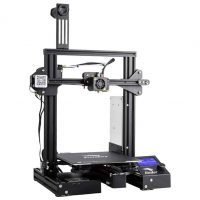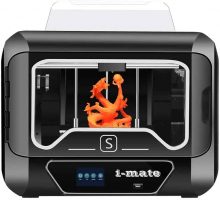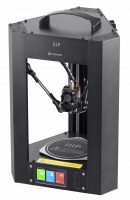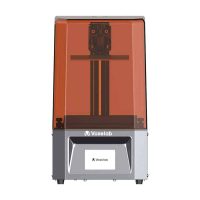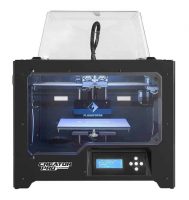Best 3D Printer For Miniatures in 2021
Design and bring to life miniatures with these top 3D printer recommendations
- Last Updated Jun 21, 2021
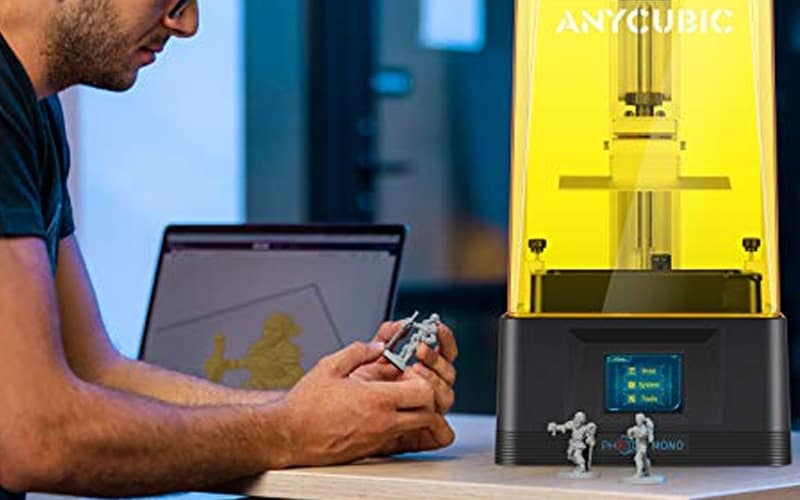
Long gone are the days of trudging down to the local Games Workshop to pay exorbitant prices for figurines. Thanks to the ubiquity of online retail, it’s cheaper and easier than ever to dive into the world of miniatures, whether that’s Warhammer, Dungeons & Dragons, or any other of the wealth of tabletop games that continue to grow in popularity with each passing year. But what if you want to try your hand at making your own bespoke miniatures?
3D printing reaching relative maturity since its DIY Kickstarter origins means designing and printing your own more affordable and accessible than ever before. The market is awash with budget printers that meet the spec required to create more than serviceable miniatures, and why not make your own games from scratch. As with most tech, the problem is wading through the glut of options and making that all-important choice.
To take some of the tedium and stress out of the equation, we’ve compiled this handy guide to the best 3D printer for miniatures.
Products at a Glance
How We Picked
While many of the usual factors that make or break the overall quality of a particular 3D printer apply in the case of miniature printing, such as construction, ease of use and assembly, build volume, calibration, connectivity, print speed, and material compatibility, the focus here moves more towards precision and fine detail. As such, when assessing what’s out there, we honed in on printers that reliably produce good quality miniatures.
After combing through the options, we shortlisted five 3D printers that, in our opinion, deliver everything you’ll need to pump out miniatures reliably. We’ve tried to offer an option for a range of budgets, from those with a sizable budget to those looking for a thrifty entry point into 3D miniature printing.
Read on for a round-up of what each 3D printer offers and what stumbling blocks it might throw your way, as well as some pros and cons for those that don’t fancy a lengthy read. Let’s start with our number one recommendation for 3D miniature printing.
Best 3D Printer For Miniatures in 2021
Affordable
Consistent high quality prints
Suited to tinkering and upgrades
Build volume
Ease of assembly
Tricky bed levelling
A hands-on printer
The Creality Ender 3 Pro is not only one of the most popular FDM 3D printers around due to its versatility and well-rounded feature set but is also a top choice for miniature printing. Much of this comes down to the consistent quality of the prints, bolstered by a vibrant community of owners, a fount of knowledge and advice to tame the Creality Ender 3 Pro to meet your miniature printing needs. It’s an affordable 3D printer that should satisfy curious beginners and hobbyists alike.
With a 0.4 mm nozzle, 100 to 400-micron resolution, 110-degree heated bed, and a 220 mm x 220 mm x 250 mm build volume, the Creality Ender 3 Pro comes with all the ingredients required to produce detailed, accurate miniatures. The build volume lends itself to everything from tiny, intricate accessories like weapons to moderately-sized figurines and even reasonably-sized background sets.
While the Creality Ender 3 Pro supports various filament types, it excels when paired with flexible materials like PLA and ABS, which for miniature printing is ideal as these are the filament of choice among veteran printers.
A word of warning: due to its DIY origins, the Creality Ender 3 Pro falls more in the tinkerer’s printer category. It is a hands-on machine ideal for those with experience or those eager to learn as they print than other options in our list. The best results are achieved through time spent getting to know the printer’s quirks rather than straight out of the box. In the same vein, the absence of auto-bed leveling can be somewhat challenging for novices.
Fully assembled
Fully assembled
0.2 – 0.4 mm nozzle
50 to 200 micron resolution
Ease of use
Expensive
3D printing can be a nasty business for your senses, not least inhaling unpleasant fumes produced when using ABS and the toxic fumes that come hand in hand with working with PLA. To that end, we’ve squeezed the FDM Qidi Technology i Mates 3D Printer into our list not just because it is a fully enclosed printer but also one that fares incredibly well when it comes to miniatures.
The user experience sits at the core of what the Qidi Technology i Mates 3D Printer is all about, with features such as a user-friendly 3.5-inch touch screen, assisted bed leveling, a power failure resume function, a flexible magnetic board, and a fully assembled design combining to deliver a stress-free, out-of-the-box printing experience. No messing around piecing together semi-assembled parts here; the Qidi Technology i Mates 3D Printer prints within minutes with next to no fuss.
As for the device’s miniature printing capabilities, we only have to look at a resolution of 50 to 200 microns alongside both a 0.2 mm and a 0.4 mm nozzle and a generous build volume of 260 mm x 200 mm x 200 mm to see that the Qidi Technology i Mates 3D Printer has all the right specifications. The results mirror this with excellent print quality. Prints come out with fine details and smooth surfaces, particularly when tackling larger models, notably taller figurines.
Other notable features include plenty of connectivity options through either Wi-Fi, wired Ethernet, or USB, as well as support for popular materials like PLA, TPU, PETG, and more. The Qidi Technology i Mates 3D Printer does hit the wallet quite hard, priced at nearly double that of the Creality Ender 3 Pro.
Delta printing technique
Very affordable price point
Automatic calibration
Fully assembled
50 micron resolution
Small build volume
Open-source design may confuse newcomers
The Monoprice 121666 is surprisingly cheap for a 3D printer at $160, something unheard of even a few years back even among DIY kits, let alone fully assembled machines such as this one. Compromises are part and parcel of the package here. Still, the Monoprice 121666 packs in enough charm and print performance to warrant a spot in anyone’s 3D printing setup, notably those creating miniatures.
Specification-wise, the printer uses a tri-point Delta design and proposes an impressive feature set commonly found in printers at least three times the price: a layer resolution from 50 to 200 microns, a 0.4 mm nozzle, a heated bed up to 122-degree Fahrenheit, automatic bed leveling, a rugged all-metal chassis, Wi-Fi/microSD/USB connectivity, a color LCD screen, and support for popular materials like ABS, PLA, and even more niche filaments such as wood Fill, copper Fill, steel Fill, bronze Fill.
The slim build volume of 110 mm (diameter) x 120 mm (height) is somewhat of a letdown, though it offers sufficient space to print decently-sized miniatures. Print performance really shouldn’t be this respectable at $160, and the results cough up very few imperfections or warping and boast decent layering that only requires minimal post-print clean-up.
Although the low price can be tempting for newcomers, the open-source design and, more importantly, the lack of included slicing software plumps down a considerable stumbling block to bringing that first print to life.
Unlike the Qidi Technology i Mates 3D Printer, which packages in everything you need to start printing, this printer involves more groundwork and a decent understanding of what goes into a 3D print, notably the slicing and setup side of the process. As such, we recommend some experience with 3D printers or the time and patience to seek out online resources as a prerequisite to squeezing the best out of the Monoprice 121666.
Build size: 5.11in(L) x 3.22in(W) x 6.10in(H)
2k Mono LCD screen
CNC Aluminium construction
Resin 3D printer
Fast printing 6-inch monochrome 2K LCD
CNC-machined aluminum construction
50 micron resolution
Limited connectivity
In many ways, resin-based 3D printing is far better suited to the demands of miniature printing. Resin 3D printers offer higher resolutions, print considerably faster than FDM printers, and the curing process generally results in more uniform and stronger prints. All this does come at a cost and limits users to only one type of material, but if you are comfortable with these limitations, the Voxelab Proxima stands as one of the best resin 3D printers for miniatures.
Made from CNC-machined aluminum, the Voxelab Proxima is a tough 3D printer that employs a spectacular 6-inch monochrome 2K LCD to create highly detailed prints at a resolution of 50 microns 1620×2560, perfect for bringing out the subtle nuances of intricately designed miniatures.
Alongside, it’s also a pretty fast printing machine, capping out at 17-22 mm per hour. As expected from resin 3D printers, prints are consistently of a high standard. The build volume tallies up to an impressive 130mm x 82mm x 155mm – more than enough for most miniatures but considerably slimmer than other printers in our guide.
The contained design lends itself to a simple user experience with an intuitive LCD layout and operation and next to no assembly to get the machine up and running. Although there is no auto bed leveling, the process is snappy enough and well-guided. Connectivity is limited to USB. This isn’t necessarily a negative for everyone but be warned before buying.
Compatible Material:Polypropylene , Pearl , Acrylonitrile Butadiene Styrene , Polyethylene Terephthalate Glycol , Polylactic Acid , Thermoplastic Elastomers , Polyvinyl Alcohol , Thermoplastic Polyurethane , High Impact Polystyrene Sheet , Metal , Aluminum , Polycarbonate , Wood
Item Volume:0 fluid_ounces
Weight:24.3 pounds
Fully enclosed design
227 mm x 150 mm x 148 mm build volume
Heated bed
Dual extruders for dual color prints
100 micron resolution
Connectivity limited to SD card
No auto bed levelling
By no means cheap, the FlashForge Creator Pro does maximize the value of each dollar spent to deliver a professional-grade printing experience for considerably less than similarly specced machines. For sheer price-to-performance, there’s little else out there that approaches the FlashForge Creator Pro.
For miniature printing, in particular, the FlashForge Creator Pro hits all the right notes: a 0.4 mm nozzle, a 100-micron resolution, a roomy 227 mm x 150 mm x 148 mm build volume, a thick heated aluminum bed, and even dual extruders for dual color prints. Material support includes PLA and ABS and extends to PVA, HIPS, TPE, TPU, PETG, wood fill, copper fill, and brass fill with the right adjustments.
Although there’s plenty going for the FlashForge Creator Pro, some desirable features are missing, chiefly automatic bed leveling and multiple connectivity options. The three-point metal leveling system is reasonably intuitive but may stump novices. Similarly, we would like to see wireless connectivity or USB alongside the SD card reader that ships with the FlashForge Creator Pro.
Things To Consider
FAQs
Our Verdict
The Creality Ender 3 Pro tops our list of recommended 3D printers for miniatures for consistently delivering high-quality prints, all at an affordable price point. It’s a perfect first printer for beginners and an easy upgrade for more seasoned hobbyists.
The Qidi Technology i Mates 3D Printer’s fully enclosed design is the headline here, but the printer performs admirably when tackling miniatures due to excellent resolution and nozzle specifications. The ease of use also makes it a strong option for those that want to 3D print free of the hassle of more hands-on kits.
Priced at only $160, the Monoprice Delta Mini shouldn’t be as good as it is. The feature set usually belongs on a much more expensive printer and the print quality towers far above what you’d reasonably expect.
Those looking to tap into the heightened precision and speed of resin-based printers to make miniatures should consider the Elegoo Mars 2. Lastly, for pure value, our money is on the ever-popular FlashForge Creator Pro.
Feel free to drop into the comments section below with any questions or concerns.

